Related Research Articles

The retina is the innermost, light-sensitive layer of tissue of the eye of most vertebrates and some molluscs. The optics of the eye create a focused two-dimensional image of the visual world on the retina, which then processes that image within the retina and sends nerve impulses along the optic nerve to the visual cortex to create visual perception. The retina serves a function which is in many ways analogous to that of the film or image sensor in a camera.

An eye is a sensory organ that allows an organism to perceive visual information. It detects light and converts it into electro-chemical impulses in neurons (neurones). It is part of an organism's visual system.

Night vision is the ability to see in low-light conditions, either naturally with scotopic vision or through a night-vision device. Night vision requires both sufficient spectral range and sufficient intensity range. Humans have poor night vision compared to many animals such as cats, dogs, foxes and rabbits, in part because the human eye lacks a tapetum lucidum, tissue behind the retina that reflects light back through the retina thus increasing the light available to the photoreceptors.

Adaptive optics (AO) is a technique of precisely deforming a mirror in order to compensate for light distortion. It is used in astronomical telescopes and laser communication systems to remove the effects of atmospheric distortion, in microscopy, optical fabrication and in retinal imaging systems to reduce optical aberrations. Adaptive optics works by measuring the distortions in a wavefront and compensating for them with a device that corrects those errors such as a deformable mirror or a liquid crystal array.

The macula (/ˈmakjʊlə/) or macula lutea is an oval-shaped pigmented area in the center of the retina of the human eye and in other animals. The macula in humans has a diameter of around 5.5 mm (0.22 in) and is subdivided into the umbo, foveola, foveal avascular zone, fovea, parafovea, and perifovea areas.
Naked eye, also called bare eye or unaided eye, is the practice of engaging in visual perception unaided by a magnifying, light-collecting optical instrument, such as a telescope or microscope, or eye protection.

Peripheral vision, or indirect vision, is vision as it occurs outside the point of fixation, i.e. away from the center of gaze or, when viewed at large angles, in the "corner of one's eye". The vast majority of the area in the visual field is included in the notion of peripheral vision. "Far peripheral" vision refers to the area at the edges of the visual field, "mid-peripheral" vision refers to medium eccentricities, and "near-peripheral", sometimes referred to as "para-central" vision, exists adjacent to the center of gaze.

The field of view (FOV) is the angular extent of the observable world that is seen at any given moment. In the case of optical instruments or sensors, it is a solid angle through which a detector is sensitive to electromagnetic radiation. It is further relevant in photography.

Observational astronomy is a division of astronomy that is concerned with recording data about the observable universe, in contrast with theoretical astronomy, which is mainly concerned with calculating the measurable implications of physical models. It is the practice and study of observing celestial objects with the use of telescopes and other astronomical instruments.
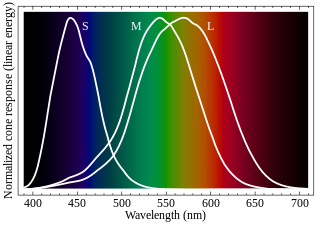
Cone cells or cones are photoreceptor cells in the retinas of vertebrates' eyes. They respond differently to light of different wavelengths, and the combination of their responses is responsible for color vision. Cones function best in relatively bright light, called the photopic region, as opposed to rod cells, which work better in dim light, or the scotopic region. Cone cells are densely packed in the fovea centralis, a 0.3 mm diameter rod-free area with very thin, densely packed cones which quickly reduce in number towards the periphery of the retina. Conversely, they are absent from the optic disc, contributing to the blind spot. There are about six to seven million cones in a human eye, with the highest concentration being towards the macula.
In visual physiology, adaptation is the ability of the retina of the eye to adjust to various levels of light. Natural night vision, or scotopic vision, is the ability to see under low-light conditions. In humans, rod cells are exclusively responsible for night vision as cone cells are only able to function at higher illumination levels. Night vision is of lower quality than day vision because it is limited in resolution and colors cannot be discerned; only shades of gray are seen. In order for humans to transition from day to night vision they must undergo a dark adaptation period of up to two hours in which each eye adjusts from a high to a low luminescence "setting", increasing sensitivity hugely, by many orders of magnitude. This adaptation period is different between rod and cone cells and results from the regeneration of photopigments to increase retinal sensitivity. Light adaptation, in contrast, works very quickly, within seconds.
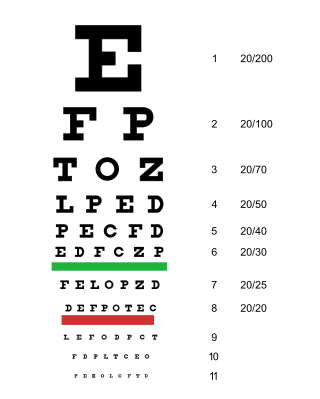
Visual acuity (VA) commonly refers to the clarity of vision, but technically rates an animal's ability to recognize small details with precision. Visual acuity depends on optical and neural factors. Optical factors of the eye influence the sharpness of an image on its retina. Neural factors include the health and functioning of the retina, of the neural pathways to the brain, and of the interpretative faculty of the brain.
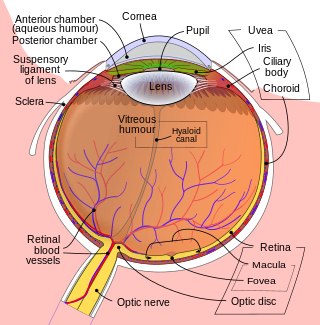
The fovea centralis is a small, central pit composed of closely packed cones in the eye. It is located in the center of the macula lutea of the retina.
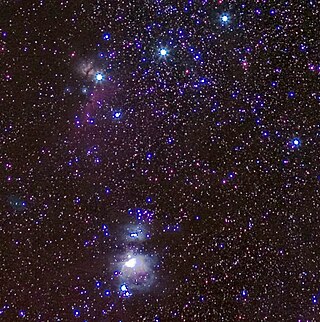
A deep-sky object (DSO) is any astronomical object that is not an individual star or Solar System object. The classification is used for the most part by amateur astronomers to denote visually observed faint naked eye and telescopic objects such as star clusters, nebulae and galaxies. This distinction is practical and technical, implying a variety of instruments and techniques appropriate to observation, and does not distinguish the nature of the object itself.
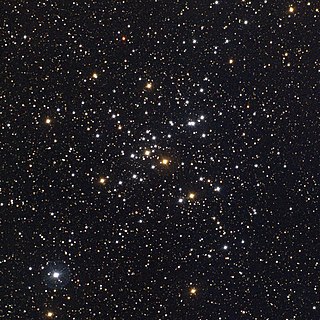
Messier 41 (also known as M41 or NGC 2287) is an open cluster in the constellation Canis Major. It is sometimes referred to as the Little Beehive Cluster. It was discovered by Giovanni Batista Hodierna before 1654 and was perhaps known to Aristotle about 325 BC. It lies about four degrees almost exactly south of Sirius, with which it forms a roughly equilateral triangle with Nu2 Canis Majoris to the west—all three figure in the same field in binoculars.

In astronomy, limiting magnitude is the faintest apparent magnitude of a celestial body that is detectable or detected by a given instrument.

The night sky is the nighttime appearance of celestial objects like stars, planets, and the Moon, which are visible in a clear sky between sunset and sunrise, when the Sun is below the horizon.
In the study of visual perception, scotopic vision is the vision of the eye under low-light conditions. The term comes from the Greek skotos, meaning 'darkness', and -opia, meaning 'a condition of sight'. In the human eye, cone cells are nonfunctional in low visible light. Scotopic vision is produced exclusively through rod cells, which are most sensitive to wavelengths of around 498 nm and are insensitive to wavelengths longer than about 640 nm. Under scotopic conditions, light incident on the retina is not encoded in terms of the spectral power distribution. Higher visual perception occurs under scotopic vision as it does under photopic vision.

A finderscope is an accessory sighting device used in astronomy and stargazing, typically a small auxiliary refracting telescope/monocular mounted parallelly on a larger astronomical telescope along the same line of sight. The finderscope usually has a much smaller magnification than the main telescope, thus providing a larger field of view, useful for manually pointing the main telescope into a roughly correct direction that can easily place a desired astronomical object in view when zooming in. Some finderscopes have sophisticated reticles to more accurately aim the main telescope and/or even perform stadiametric measurements.

Mammals normally have a pair of eyes. Although mammalian vision is not as excellent as bird vision, it is at least dichromatic for most of mammalian species, with certain families possessing a trichromatic color perception.
References
- ↑ Berman, Bob, “Tormented by open clusters”, Astronomy, March 2019, p. 12.
- ↑ Alexander, RG; Mintz, RJ; Custodio, PJ; Macknik, SL; Vaziri, A; Venkatakrishnan, A; Gindina, S; Martinez-Conde, S (2021). "Gaze mechanisms enabling the detection of faint stars in the night sky". European Journal of Neuroscience. 54 (4): 5357–5367. doi:10.1111/ejn.15335. PMC 8389526 . PMID 34160864.
- ↑ M41 possibly recorded by Aristotle
- ↑ Dyer, JL; Mittelman, MH (1998). "Evaluation of an unaided night vision instructional program for ground forces". Military Psychology. 10 (3): 159–172. doi:10.1207/s15327876mp1003_2.
- ↑ Azevedo, FS; Mann, MJ (2016). Embodied Cognition in Observational Amateur Astronomy. International Conference of the Learning Sciences. International Society of the Learning Sciences.
- ↑ Griffiths, M (2012). Planetary Nebulae and How to Observe Them. Springer Science & Business Media. p. 33.
- ↑ Wells-Gray, E. M.; Choi, S. S.; Bries, A.; Doble, N. (2016). "Variation in rod and cone density from the fovea to the mid-periphery in healthy human retinas using adaptive optics scanning laser ophthalmoscopy". Eye. 30 (8): 1135–1143. doi:10.1038/eye.2016.107. PMC 4985666 . PMID 27229708.
- ↑ Alexander, RG; Mintz, RJ; Custodio, PJ; Macknik, SL; Vaziri, A; Venkatakrishnan, A; Gindina, S; Martinez-Conde, S (2021). "Gaze mechanisms enabling the detection of faint stars in the night sky". European Journal of Neuroscience. 54 (4): 5357–5367. doi:10.1111/ejn.15335. PMC 8389526 . PMID 34160864.